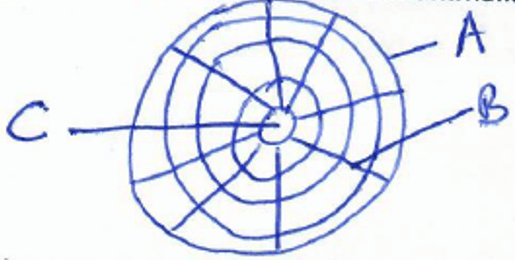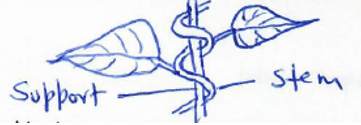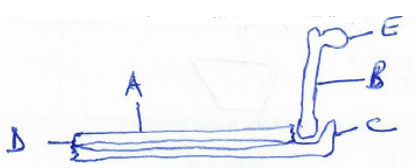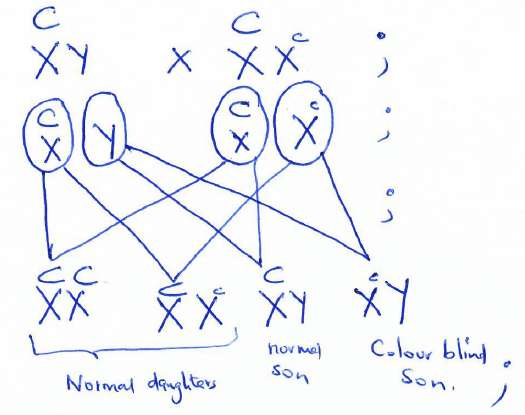QUESTIONS
- Differentiate nutrition in plants from that in animals. (2 marks)
- State and explain three modes of feeding in animals. (3 marks)
- Name two properties of disaccharides. (2 marks)
- Explain three adaptations of arteries to their function. (3 marks)
- Explain what happens during photolysis? (3 marks)
- An experiment was set up as shown.

- State and explain what happened to visking tubings in both M and N. (4 marks)
- What does visiting tubing correspond to in a living organism? (1 mark)
- State three digestive enzymes present in pancreatic juice. (3 marks)
- Colour blindness is a condition carried by a recessive gene on X-chromosome. A colour blind man married a homozygous normal woman. One of their daughters married a normal man. Using letter c for colour blindness,
- Work out the outcome of the daughter's marriage. (4 marks)
- Why is colour blindness more common in men than women? (2 marks)
- The figure below shows the iris of a mammalian eye.

- Label the parts A, B and C. (3 marks)
- ................................................................
- ................................................................
- ................................................................
- State three adaptations of the iris to its function. (3 marks)
- Label the parts A, B and C. (3 marks)
- The diagram below shows a stem twining round a support.

- Explain how this phenomenon occurs (3 marks)
- Explain three biological significance of this phenomenon. (3 marks)
- The base sequence on a DNA strand was as follows;
A --- T --- A --- A ---- C ---- G --- G ---- T ---- A- Write the sequence on the other strand. (1 mark)
- Write the base sequence on RNA strand replicated from the DNA. (1 mark)
- Explain four adaptations of hydrophytes to their habitat. (4 marks)
-
- List three differences between the nervous system and the endocrine system. (3 marks)
- Name two transmitter substances found in the synapse. (2 marks)
- Explain four roles of water in seed germination. (4 marks)
-
- Name two plant cells where you would expect to have numerous mitochondria. (2 marks)
- State one role of nucleolus. (1 mark)
- Explain three adaptations of the sperm cell to its function. (3 marks)
- The diagram below shows arrangements of bones on human forelimb.

- Name bones A and B. (2 marks)
- ................................................................
- ................................................................
- State two roles of the structure labelled C (2 marks)
- Name the part that articulates with bone labelled B at part E. (1 mark)
- Name the type of joint forms at the part labelled D. (1 mark)
- Name bones A and B. (2 marks)
-
- State two special properties of the cardiac muscles found in mammalian heart. (2 marks)
- Name three organ systems in human body where smooth muscles are found. (3 marks)
- State three unique characteristics of members of the class Crustacea. (3 marks)
- Industrial wastes may contain metabolic pollutants. State how such pollutants may indirectly reach and accumulate in the human body if the wastes were dumped into rivers. (3marks)
- State three biotic factors that affect distribution of living organisms in an ecosystem. (3marks)
MARKING SCHEME
- Plants make own food,(autotrophic); while animals take ready-made food,(heterotrophic);
-
- Carnivorous-feed on flesh;
- Herbivorous- feed on vegetation/plants;
- Omnivorous-feed on both flesh and vegetation;
-
- soluble in water;
- sweet tasting;
- crystalline;
-
- Have narrow lumen to maintain high blood pressure;
- Have a thick elastic wall to help blood flow;
- Have no valves so blood flow is not inhibited;
- Water molecule; is split by light energy; into hydrogen ions and oxygen gas;
-
- M- decreased in size;
- distilled water is hypotonic; so water molecules mover into salt solution by osmosis;
- N- Decreased in size;
- Salt solution is hypertonic; so water molecules moved out of tubing by osmosis;
- cell membrane;
- M- decreased in size;
-
- Pancreatic amylase;
- Pancreatic lipase;
- Trypsin;
-
-

- All men with the gene are colour blind; women with one gene are normal but carriers;
-
-
- A- Circular muscle;
B- Radial muscle;
C -pupil; -
- pigmented to absorb light controlling amount entering;
- has radial and circular muscles to control size of pupil controlling amount of light entering eye;
- it gives the eye colour;
- A- Circular muscle;
-
- Auxin; moves away from point of touch; causing faster growth on other side; resulting in coiling growth;
-
- expose leaves to light for photosynthesis;
- expose flowers to agents of pollination;
- expose fruits and seeds to agents of dispersal;
-
- T --- A ---- T----T ---- G ---- C ---- C ---- A ---- T;
- U ----A --- U ---- U ---- G ---- C ---- C --- A ---- U;
-
- Roots with no root hairs to reduce absorption;
- Numerous stomata on upper surface of leaves to increase transpiration;
- Large air spaces to increase buoyancy;
- Large leaves to increase surface area exposed for transpiration increase;
-
-
Nervous
Endocrine
Nerve impulse evoke response
Chemical evoke a response;
Transmitted through neurones;
Transmitted through blood;
Response is rapid
Response is slow;
Effect short lived
Effect is long lasting;
-
- Noradrenaline;
- Acetylcholine;
-
-
- Activate germination enzymes;
- Hydrolyses stored food;
- Transport food to embryo;
- Dilute germination inhibitors;
- Soften the seed coat;
-
-
- Root hair cells;
- Companion cell;
- cells in meristematic tissue;
- Formation of ribosomes;
-
-
- Has acrosome containing lytic enzymes that digest egg membrane;
- Has a long tail for swimming to the ovum;
- Has numerous mitochondria to provide energy for swimming to the ovum;
- It's streamlined in shape for minimum resistance to movement;
-
- A- radius;
B- Humerus; - Attachment of triceps muscle;
Prevent overstretching of the arm; - Glenoid cavity;
- Glinding joint;
- A- radius;
-
-
- They are myogenic;
- Contract and relax continuously without fatigue;
-
- Digestive system;
- Reproductive system;
- Circulatory system;
-
- Have a carapace;
- Have two pairs of antennae;
- Have five pairs of legs;
-
- Pollutants are absorbed by aquatic plants; which are eaten by primary consumers e.g. fish; man accumulates the pollutants by eating fish regularly;
- Competition;
Predation;
Parasitism;
Saprophytism;
Symbiosis;
Download Biology Paper 1 Questions and Answers - Kigumo Mocks 2021 Exams.
Tap Here to Download for 50/-
Get on WhatsApp for 50/-
Why download?
- ✔ To read offline at any time.
- ✔ To Print at your convenience
- ✔ Share Easily with Friends / Students

